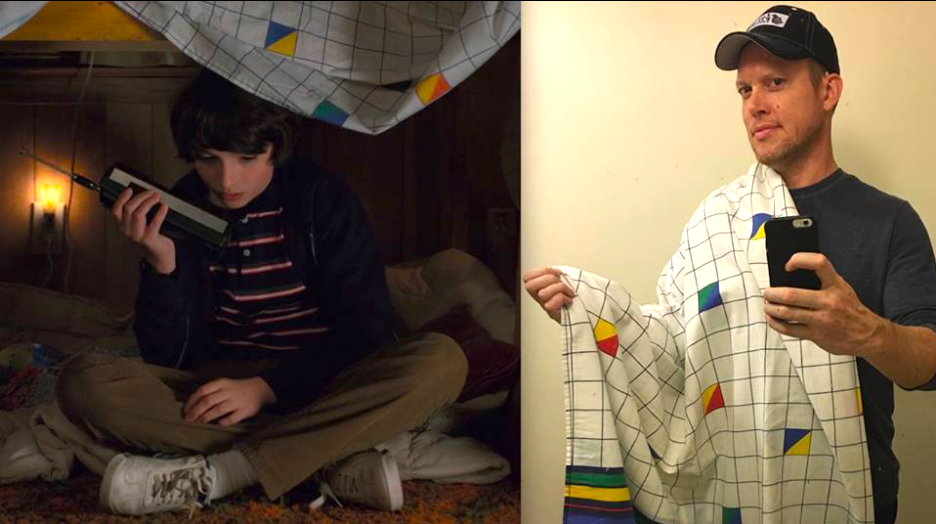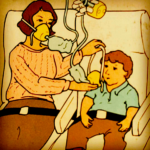Count me among the many people who can’t watch the Netflix show Stranger Things without feeling a rush of 1980s nostalgia. The young boys in the show are the exact same age I was in 1985, and at times the show’s motifs are so evocative of the era that I can practically smell the halls of my old junior high school.
I realize that nostalgia can be seen as an insipid, faintly manipulative sensation – but if my reaction to Stranger Things is any indication, it’s not a voluntary condition; it’s just a feeling that wells up inside you in certain moments. On one hand the show evokes the 1980s through its Spielberg-meets-Stephen-King mode of storytelling – yet even if one takes away its action sequences and ooze-dripping monsters, one is still left with a show that evokes something true about what it was like to be alive in that era.
I know this because, after noting the date-tags on the first episode, I dug up the texts of the journals I kept between 1984 and 1986 – a time when I played D&D, bicycled everywhere, savored trips to the mall, and pretty much watched the same movies and TV shows as the boys in the show. The similarities I read in those journals were at times startling.
This post is an exploration of Stranger Things‘ depiction of the mid-1980s in light of the actual mid-1980s I recorded in those journals.
0) First, a note on re-reading one’s old journals
One intriguing thing about the journals I kept in the mid-1980s is that they are largely devoid of reflections on my feelings at the time (no doubt because I was terrified someone might read them). Mostly I just wrote about where I went, what I did, games and sports I played, what I read in books, or what I watched on TV or at the movies.
In general, my mid-1980s journals didn’t record a particularly iconic or groundbreaking time for me personally; they simply evoke the day to day life of a boy in transition from being 13 years old to 15 years old. My life in 2019 is better in so many ways than it was in 1985 – no doubt because as adults we have way more agency than we did back then (I am, after all, writing this from Paris at the moment) – yet it was strangely resonant for me to revisit the mindset of the boy I once was.
As is the central theme in Season Three of Stranger Things, my life between 1984 and 1986 was, I have come to realize in retrospect, very much about change – and perhaps it is the inevitability of change, combined with concrete memories of what once was, that creates sensations of nostalgia.
Here are five key observations about Stranger Things‘ evocation of the mid-1980s, versus my own real-life mid-1980s, based on my journals from the time.
1) Young nerds in the mid-1980s contained multitudes
The very first time we see Dustin, Lucas, Mike, and Will in the Stranger Things pilot episode, they are playing Dungeons and Dragons. Like those boys, I played a ton of D&D when I was that age – particularly, it would seem, in 1984.
Unlike those boys, the orthodoxy with which I played D&D depended upon whom I played it with. My friend Keith, who owned a number of D&D books, tended to play by the rules, whereas my pal Bryan would just make things up as he went along. (Note the pure 1980s-ness of such journal lines as: “Bryan spends the night. We play D&D and watch Carson until we fall asleep.”) I also took school seriously, went to Boy Scouts and church youth outings, and – with a degree of obsessiveness D&D couldn’t touch – watched countless hours of Dr. Who on the local PBS station.
In short, I was – like the boys on Stranger Things – a nerd, right down to my skinny build, unkempt hair, and plastic-framed eyeglasses. That said, I don’t think that young nerds are ever as stereotypical as they appear on TV shows – or, at least, I certainly wasn’t.
Unlike Dustin, Lucas, Mike, and Will, I was, at that age, fixated with – and quite good at – sports. My 1984 journal dedicates tons of ink to the summer Olympics in LA (I was scandalized when Zola Budd appeared to trip Mary Decker in the women’s 3000m; I was outraged when Evander Holyfield was disqualified in boxing by a Yugoslavian judge), and I exuded delight when, say, the Wichita Wings won indoor soccer games, or the Kansas City Royals clinched the 1984 AL West crown. I noted USFL football scores as readily as NFL ones, and I watched events like horse racing and tobogganing on ABC’s Wide World of Sports.
TV sports aside, I threw myself into competitive soccer, running, and swimming – and I played lots of pickup basketball and football with my friends. I was competitive in gym class to the point of obnoxiousness (carefully recording softball and flag-football victories in my journal), and I won the one-mile swim at Boy Scout camp. My dedication to running was, in retrospect somewhat staggering – I often went for full five-mile runs an hour before playing indoor soccer games, and at least five times in 1984 I went for runs of ten miles or more with my dad (who was training for a marathon at the time).
By comparison the boys in Stranger Things are a lot less sports-oriented – though I’d reckon fighting malevolent monsters from the Upside Down might be considered a sport in and of itself.
2) My TV, movies, and video games habits were very 80s-specific
One reason why Stranger Things is such a vessel of 1980s nostalgia is that it deliberately riffs on the mainstream pop-culture of the era – in an era when mainstream pop-culture was far more dominant than it was now.
Season Three of the show borrows from or evokes movies I watched and loved at the time – movies like Red Dawn, The Terminator, Fast Times at Ridgemont High, and Close Encounters of the Third Kind. TV shows like Magnum P.I. and movies like Back to the Future get specific screen-time in Season Three of Stranger Things, but if my old journals are any indication, young people spent a lot of time in that era watching forgettable entertainments as well.
Sure, I watched iconic 80s shows like, the A-Team, the Cosby Show, Family Ties, M*A*S*H, and Knight Rider, but I also tuned in for shows I scarcely remember – shows like Riptide, Airwolf, Simon & Simon, and Double Trouble. I watched TV movies like World War III, clip-shows like Not Necessarily TV, and miniseries like V: The Final Battle. My family did not, at the time subscribe to cable TV (nor did we have a VCR), so I had to watch MTV and Showtime at friends’ houses. I watched so much Dr. Who that most weeks in my 1984 journal mention the show at least 2-3 times.
Most of the movies I watched (Caddyshack, Stripes, Escape from Alcatraz, Moonraker, The Jerk, Conan the Barbarian, Slapshot) I caught on weekly network slots like the “ABC Sunday Night Movie” – though I did occasionally get to the mall to see movies like Ghostbusters, Teen Wolf, or 2010: The Year We Make Contact. In 1985 I tried to sneak in to see R-rated Rambo with my friends Bryan and Jeff, but we got kicked out and had to watch Fletch (which we liked just fine) instead.
In Season Two of Stranger Things the boys frequent a Hawkins video game parlor called “The Palace,” which is more or less the equivalent of “LeMans,” the Wichita game-room where I would sometimes play Ms. Pac-Man, Frogger, and Star Trek in 1984. According to my journals, however, I played most of my video games at home, or at my friends’ houses.
My friend Lance had an Atari 5200 that enabled iconic video games like Pac-Man and Jungle Hunt. Many of my friends had Commodore 64s (and I had a cut-rate version of the 64 called Vic-20), which were popular with parents since, with their keyboards and quasi-educational programs, they could also pass as primitive personal computers. These consoles featured arcade-knockoff games like Snakman, Kongo Kong, Demon Attack, and Choplifter. By 1985 some of my friends had gotten Apple IIcs or Apple IIes, and they traded pirated versions of games like Night Driver, Swashbuckler, and Spy vs. Spy on unwieldy 5 ¼ inch floppy disks.
My mid-1980s journals also note the books I read. In 1984 I read George Orwell’s 1984, as well as Animal Farm. I read Frank Herbert’s Dune, C.S. Lewis’s The Lion, the Witch, and the Wardrobe, Douglas Adams’s Hitchhiker’s Guide to the Galaxy, and – apparently – a book called Utterly Gross Jokes: 5.
In keeping with the spirit of Stranger Things I also read a ton of Stephen King – including Christine, Cujo, Firestarter, Pet Sematary, and Skeleton Crew. Moreover, my writing career may well trace back to “Therapy,” a Stephen King-inspired short story (about a therapist who tries to treat a dead client) I wrote in 1985.
3) The mall was vital (but it was one of many places)
Season Three of Stranger Things focuses on the Starcourt Mall, which – in addition to bankrupting businesses in central Hawkins – appears to conceal a Soviet facility designed to research and penetrate the Upside Down. I also spent a fair amount of time in shopping malls around that time – though in mid-1980s Wichita the flashy new mall (Towne West Square) wasn’t competing with downtown businesses so much as it was compromising an older west-Wichita mall (Twin Lakes) that had been around since the 1960s. As it happened, my shopping time was split between both places.
My grandmother lived in a retirement apartment-complex adjacent to Twin Lakes, so I spent a lot of time there by default. I took the “Pepsi Challenge” there in 1983, and selected Coke (most people picked Pepsi, a factor that directly led to the creation of “New Coke” – which ends up making a cameo in Season Three of Stranger Things). Twin Lakes was also within walking distance of my home (in 1985 a five-mile round-trip still counted as “walking distance”) which meant it was home to the cinema where I first traveled on my own to see movies like Return of the Jedi and The Karate Kid.
Like downtown Hawkins, however, Twin Lakes Mall wasn’t the place where young teens went in 1985 to see their friends. For me that place was Towne West Square, which – like Starcourt Mall – featured stores like JC Penney, Waldenbooks, Orange Julius, Esprit, Zales, and Chess King. I didn’t hang out regularly in this mall, but I always noted it in my journal when I did: I bought Bruce Springsteen’s Born in the USA for my sister there before Christmas in 1984; I got a pair of green-framed faux Ray-Bans (not unlike what Eleven and Max buy in their Stranger Things mall sequence) at Spencer Gifts the following spring.
Shopping malls nationwide have, of course, lost their share of the teen market in the past two decades, thanks in large part to things like iPhones and Amazon. Wichita’s Towne West Square, which was the default social hub for teens in 1985, was recently sold to a New York-based investment group for $14 million (which is $30 million less than the loan that financed the property). “It was popular back in the 80s,” one Towne West client told the press, “but now it’s different. You’re starting to see these malls repurposed into doctors’ offices and call centers.”
Indeed, as with the core themes of Stranger Things, the changes that once led to the decline of downtown shopping districts are now affecting the very malls that displaced those downtown shopping districts.
It would be a mistake, however, to assume that shopping malls were the only outlet for early teen autonomy in the mid-1980s.
4) Free-range kids were well-raised kids
Though Season Three of Stranger Things – and the 1980s pop-culture it imitates – might infer that shopping malls were the primary place for Midwestern young people to exercise a degree of social independence in 1985, my journal from that era implies otherwise. Indeed, the bicycle – an analog technology which featured prominently in earlier seasons of Stranger Things – afforded me a degree of mobility and self-determination that far outstripped what was possible in shopping malls. My journal entries regularly mention ten-mile excursions into and around downtown Wichita, or 25-mile bike treks for camping and fishing at Cheney Reservoir outside of town.
The 1980s (and perhaps, in some places, the 1990s) are remembered as the final era in which it was possible to have a “free-range childhood.” In that era before everyone had a smartphone in their pocket, a specific slice of geography – the place where you were in a given moment – is what shaped your day. The functional setting of Stranger Things is not Hawkins but the 1980s in general, yet real life in the 1980s played out with a concrete sense of place unique to its time. Some of my earliest acts of financial autonomy – budgeting what money I had to see a planetarium show, or to feed myself at a downtown Burger King – were made possible by pedaling, alone or with friends, beyond the purview of my childhood home.
By the standards of 2019 the idea of 14-year-olds wandering around the city unsupervised sounds like a gesture of neglect on the part of the parents. Yet, in a way that can be hard to describe now, being afforded that kind of autonomy in the mid-1980s was a key asset in helping me grow into the person I eventually became. Were I to tally the privileges I have been afforded in life, having two thoughtful, engaged, trusting parents would land at the very top of that list. Without intentionally attempting to capture a portrait of my parents, my mid-1980s journals abound with examples of, say, my mom making sure I got tangible educational value out of whatever I happened to be doing, or my dad cheering at my indoor soccer games and joining me on five-mile runs.
The fruits of my parent-endorsed kid-autonomy differed from year to year. In 1984 nighttime excursions to darkened corners of my neighborhood yielded an abundance of astronomy-related star and constellation references (Rigel, Procyon, Pollux, Castor, Betelgeuse, Canus Major, Taurus) in my journal. By 1986, those nighttime excursions were more likely undertaken to drop in on friends, or to sneak into and explore an abandoned house ten blocks away.
In a sense the stargazer I was in 1984 was much sweeter and nerdier and more appealing than the more sullen trespasser I was in 1986, but – as Stranger Things very vividly illustrates in its third season – the inevitability of change is part of what defines one’s childhood.
5) Life-changes happen faster than TV lets on
The most universally beloved moment of Stranger Things Season Three comes in its final episode, when Eleven reads a heartbreaking letter left for her by Hopper (who appears to have been killed earlier in the episode). “I know you’re getting older, growing, changing,” he writes. “I guess, if I’m being really honest, that’s what scares me. I don’t want things to change. …But that’s just not how life works. It’s always moving, whether you like it or not. Sometimes it’s sad. And sometimes, it’s surprising. Happy.”
As moving as I found Hopper’s letter to Eleven, I resonated even more with a sequence several episodes earlier, when Will tries to initiate a game of D&D, the activity that once bound him to his best friends. When Mike and Lucas respond to Will with ambivalence at the prospect of playing, it felt like one of the truest moments of the season. Indeed, the things that we once loved – the things we savored with our friends in the very recent past – inevitably lose meaning as our friends (and our selves) change.
The most striking aspect of my 1984-1986 journals is the way that my 1986-self comes to scorn the same things my 1984-self loved. Dr. Who, Boy Scouts, and D&D – as well as many of the friends I spent time with in 1984 –are later seen by my 1986-self as embarrassing signifiers of a nerdiness I was trying to shake off. I did manage to become a lot less nerdy (and a lot more socially popular at school) by 1986, but I was also a bit meaner, a bit pettier, a bit more self-interested.
One of my more symbolic acts of 1986, as I became a harder-edged young teen, was to seek (and pay for) my own haircut. I chose a style popular with the kids I liked at the time – a style that was short on the top and sides, with a longer fringe in the back (which, in the spring of 1986, I got permed). This distinctive 1980s hairstyle – later ridiculed in 1990s popular culture as “the mullet” – feels emblematic of the changes I was going through at the time. In retrospect I far prefer the 1984-Rolf who loved Dr. Who and sported a mom-haircut, yet it feels like I had to pass through my meaner, mulleted, 1986-Rolf phase to evolve into the adult I later became.
What TV shows like Stranger Things sometimes miss (even as they attempt to account for it) is just how fast we change from year to year when we’re teenagers. I didn’t keep a journal in 1987, 1988, or 1989, but the person I was within those years was profoundly different than the person I was in 1984 or even 1986 (in part, but not limited to the fact that 1989-Rolf was a full foot taller in stature than 1986-Rolf). As viewers, it’s easy to idealize Dustin, Lucas, Mike, and Will as we see them in Season One of Stranger Things, but perhaps we do this because TV – unlike real life – offers us the opportunity to relive (and revisit, and rewind) earlier, simpler versions of ourselves.
As Stranger Things Season Three (and my mid-1980s journal) reveals, those simpler versions of ourselves are invariably subject to the process of change itself – a process that plays a part in making us into the adults we will later become.
Note: I don’t host a “comments” section, but I’m happy to hear your thoughts via my Contact page. To learn more about what this blog is all about, read items #2 and #3 from my update post.





